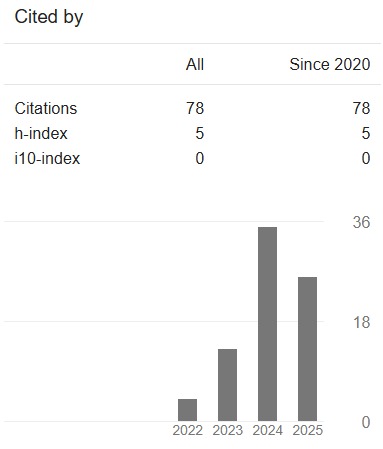Numerical Predictions on the Wake Interference Flow in Two-dimensional Street Canyon based on Various RANS Turbulence Closure Models
DOI:
https://doi.org/10.24191/jaeds.v5i2.140Keywords:
Wake interference flow, street canyon, RANS, urban ventilation, wind environmentAbstract
The precise numerical prediction of urban flow patterns is crucial for evaluating ventilation performance, pollution dispersion, and pedestrian comfort in densely built environments. Among these types of patterns, the wake interference flow poses a distinct modeling difficulty due to its complex vortex dynamics. This study performs a series of steady Reynolds-Averaged Navier-Stokes (RANS) simulations to evaluate the predictive efficiency of five turbulence closure models: standard k-ε (STD), renormalisation group k-ε (RNG), realizable k-ε (RLZ), shear-stress transport k-ω (SST), and Reynolds stress model (RSM) in a two-dimensional (2D) idealized street canyon with an aspect ratio of 3 within the wake interference flow regime. The predicted results are compared with wind tunnel experimental data using velocity profiles, statistical validation metrics, and streamlines visualization. The results demonstrate that the quantitative assessment utilizing the factor of two observations (FAC2) distinctly reveals a satisfactory predicted of streamwise velocity within the street canyon, topped by RNG (0.92) and followed by STD (0.91), RSM (0.90), SST (0.89), and RLZ (0.88). Nevertheless, all models inadequately predict the vertical velocity, as the FAC2 values fall below the threshold of 0.5. The qualitative assessment of the velocity streamlines indicates that the RNG and STD predictions closely resemble the flow pattern obtained from the experimental results that determine the main characteristics of the wake interference flow regime. Other models exhibited inadequate performance due to the observation of completely different flow patterns. Consequently, it can be concluded that while all models can estimate the streamwise velocity in the wake interference regime with good accuracy, substantial constraints persist in predicting the in-canyon vertical velocity. The observed limitations, together with the apparent variation between models in replicating secondary vortex formations, suggest several avenues for future investigations.
Downloads
References
J. Hang, X. Chen, G. Chen, T. Chen, Y. Lin, Z. Luo, X. Zhang, Q. Wang, The influence of aspect ratios and wall heating conditions on flow and passive pollutant exposure in 2D typical street canyons, Build Environ 168 (2020). https://doi.org/10.1016/j.buildenv.2019.106536.
Y. dong Huang, C. Long, J. tong Deng, C.N. Kim, Impacts of Upstream Building Width and Upwind Building Arrangements on Airflow and Pollutant Dispersion in a Street Canyon, Environ Forensics 15 (2014) 25–36. https://doi.org/10.1080/15275922.2013.872714.
T.N.H. Chung, C.H. Liu, On the Mechanism of Air Pollutant Removal in Two-Dimensional Idealized Street Canyons: A Large-Eddy Simulation Approach, Boundary Layer Meteorol 148 (2013) 241–253. https://doi.org/10.1007/s10546-013-9811-4.
T.R. Oke, Street Design and Urban Canopy Layer Climate, 1988.
J. Hang, L. Chen, Y. Lin, R. Buccolieri, B. Lin, The impact of semi-open settings on ventilation in idealized building arrays, Urban Clim 25 (2018) 196–217. https://doi.org/10.1016/j.uclim.2018.07.003.
M.F. Ibrahim, M.F. Mohamad, N. Ikegaya, A.A. Razak, Numerical Investigation of Flow and Dispersion over Two-Dimensional Semi-Open Street Canyon, CFD Letters 15 (2023) 53–70. https://doi.org/10.37934/cfdl.15.2.5370.
X. Zheng, H. Montazeri, B. Blocken, Impact of building façade geometrical details on pollutant dispersion in street canyons, Build Environ 212 (2022). https://doi.org/10.1016/j.buildenv.2021.108746.
M.G. Badas, M. Garau, G. Querzoli, How gable roofs change the mechanisms of turbulent vertical momentum transfer: A LES study on two-dimensional urban canyons, Journal of Wind Engineering and Industrial Aerodynamics 209 (2021). https://doi.org/10.1016/j.jweia.2020.104432.
M.G. Badas, S. Ferrari, M. Garau, G. Querzoli, On the effect of gable roof on natural ventilation in two-dimensional urban canyons, Journal of Wind Engineering and Industrial Aerodynamics 162 (2017) 24–34. https://doi.org/10.1016/j.jweia.2017.01.006.
S. Ferrari, M.G. Badas, M. Garau, A. Seoni, G. Querzoli, The air quality in narrow two-dimensional urban canyons with pitched and flat roof buildings, Int. J. Environment and Pollution 62 (2017) 347–368.
A.A. Aliabadi, E.S. Krayenhoff, N. Nazarian, L.W. Chew, P.R. Armstrong, A. Afshari, L.K. Norford, Effects of Roof-Edge Roughness on Air Temperature and Pollutant Concentration in Urban Canyons, Boundary Layer Meteorol 164 (2017) 249–279. https://doi.org/10.1007/s10546-017-0246-1.
R. Kellnerová, L. Kukačka, K. Jurčáková, V. Uruba, Z. Jaňour, PIV measurement of turbulent flow within a street canyon: Detection of coherent motion, Journal of Wind Engineering and Industrial Aerodynamics 104–106 (2012) 302–313. https://doi.org/10.1016/j.jweia.2012.02.017.
R. Kellnerová, V. Fuka, V. Uruba, K. Jurčáková, Š. Nosek, H. Chaloupecká, Z. Jaňour, On street-canyon flow dynamics: Advanced validation of LES by time-resolved PIV, Atmosphere (Basel) 9 (2018). https://doi.org/10.3390/atmos9050161.
Y. Zhao, H. Li, A. Kubilay, J. Carmeliet, Buoyancy effects on the flows around flat and steep street canyons in simplified urban settings subject to a neutral approaching boundary layer: Wind tunnel PIV measurements, Science of the Total Environment 797 (2021). https://doi.org/10.1016/j.scitotenv.2021.149067.
Y. Luo, Z. Yin, Q. Liang, C. Yao, C. Bao, Y. Wu, Y. Huang, Effects of tree characteristics and arcade design on the traffic pollutant dispersion inside the asymmetric street canyon, Sustain Cities Soc 122 (2025). https://doi.org/10.1016/j.scs.2025.106244.
N. Mishra, A.K. Patra, A. Penchala, S. Santra, Numerical investigation of the influence of street length and building configurations on ventilation and pollutant dispersion in idealized street canyons, Journal of Wind Engineering and Industrial Aerodynamics 257 (2025). https://doi.org/10.1016/j.jweia.2025.106016.
Y. Wang, K. Zhong, J. He, J. Cheng, M. Qi, Y. Kang, Impacts of pollution from surrounding street canyons on air cleanliness in urban ventilation corridors, Sustain Cities Soc 130 (2025). https://doi.org/10.1016/j.scs.2025.106552.
S.M. Salim, R. Buccolieri, A. Chan, S. Di Sabatino, Numerical simulation of atmospheric pollutant dispersion in an urban street canyon: Comparison between RANS and LES, Journal of Wind Engineering and Industrial Aerodynamics 99 (2011) 103–113. https://doi.org/10.1016/j.jweia.2010.12.002.
Y. Huang, X. Hu, N. Zeng, Impact of wedge-shaped roofs on airflow and pollutant dispersion inside urban street canyons, Build Environ 44 (2009) 2335–2347. https://doi.org/10.1016/j.buildenv.2009.03.024.
Y.K. Ho, C.H. Liu, M.S. Wong, Preliminary study of the parameterisation of street-level ventilation in idealised two-dimensional simulations, Build Environ 89 (2015) 345–355. https://doi.org/10.1016/j.buildenv.2015.02.042.
P. Qin, A. Ricci, B. Blocken, On the accuracy of idealized sources in CFD simulations of pollutant dispersion in an urban street canyon, Build Environ 265 (2024). https://doi.org/10.1016/j.buildenv.2024.111950.
M.F. Ibrahim, M.F. Mohamad, N. Ikegaya, A. Abd Razak, Numerical Investigation on the Effect of Building Overhang on the Flow within Idealised Two-dimensional Street Canyon, ESTEEM Academic Journal 17 (2021) 67–77.
W.C. Cheng, C.H. Liu, Large-Eddy Simulation of Flow and Pollutant Transports in and Above Two-Dimensional Idealized Street Canyons, Boundary Layer Meteorol 139 (2011) 411–437. https://doi.org/10.1007/s10546-010-9584-y.
A. Alwi, M.F. Mohamad, N. Ikegaya, A.A. Razak, Effect of protruding eave on the turbulence structures over two-dimensional semi-open street canyon, Build Environ 228 (2023). https://doi.org/10.1016/j.buildenv.2022.109921.
M.F. Mohamad, A. Hagishima, N. Ikegaya, J. Tanimoto, A.R. Omar, Aerodynamic effect of overhang on a turbulent flow field within a two-dimensional street canyon, 2015.
Y. Tominaga, A. Mochida, R. Yoshie, H. Kataoka, T. Nozu, M. Yoshikawa, T. Shirasawa, AIJ guidelines for practical applications of CFD to pedestrian wind environment around buildings, Journal of Wind Engineering and Industrial Aerodynamics 96 (2008) 1749–1761. https://doi.org/10.1016/j.jweia.2008.02.058.
J. Franke, A. Hellsten, H. Schlünzen, B. Carissimo, Best Practice Guideline for the CFD Simulation of Flows in the Urban Environment: COST Action 732 Quality Assurance and Improvement of Microscale Meteorological Models, University of Hamburg, 2007.
OpenCFD, OpenFOAM, (2023). https://www.openfoam.com/ (accessed September 13, 2023).
B.E. Launder, D.B. Spalding, THE NUMERICAL COMPUTATION OF TURBULENT FLOWS, 1974.
V. Yakhot, S.A. Orszag, S. Thangam, T.B. Gatski, C.G. Speziale, Development of turbulence models for shear flows by a double expansion technique, Physics of Fluids A 4 (1992) 1510–1520. https://doi.org/10.1063/1.858424.
T.-H. Shih, W.W. Liou, A. Shabbir, Z. Yang, J. Zhu, A NEW k-ε EDDY VISCOSITY MODEL FOR HIGH REYNOLDS NUMBER TURBULENT FLOWS, 1995.
F.R. Menter, Two-equation eddy-viscosity turbulence models for engineering applications, AIAA Journal 32 (1994) 1598–1605. https://doi.org/10.2514/3.12149.
K. Hanjalic, K. Hanjalic, B.E. Launder, Hanjalic-Launder JFM Vol52 1972 A Reynolds stress model of turbulence and its application to thin shear flows, 1972.
Y. Tominaga, A. Mochida, R. Yoshie, H. Kataoka, T. Nozu, M. Yoshikawa, T. Shirasawa, AIJ guidelines for practical applications of CFD to pedestrian wind environment around buildings, Journal of Wind Engineering and Industrial Aerodynamics 96 (2008) 1749–1761. https://doi.org/10.1016/j.jweia.2008.02.058.
P.J. Roache, Quantification of uncertainty in computational fluid dynamics, Annu. Rev. Fluid. Mech 29 (1997) 123–160. www.annualreviews.org.
T. Sato, A. Hagishima, N. Ikegaya, J. Tanimoto, Wind tunnel experiment on turbulent flow field around 2D street canyon with eaves, Journal of Environmental Engineering (Japan) 81 (2016) 467–476. https://doi.org/10.3130/aije.81.467.
Y. Tominaga, T. Stathopoulos, CFD modeling of pollution dispersion in a street canyon: Comparison between LES and RANS, Journal of Wind Engineering and Industrial Aerodynamics 99 (2011) 340–348. https://doi.org/10.1016/j.jweia.2010.12.005.
K. Nakajima, R. Ooka, H. Kikumoto, Evaluation of k-ε Reynolds stress modeling in an idealized urban canyon using LES, Journal of Wind Engineering and Industrial Aerodynamics 175 (2018) 213–228. https://doi.org/10.1016/j.jweia.2018.01.034.
S.R. Hanna, O.R. Hansen, S. Dharmavaram, FLACS CFD air quality model performance evaluation with Kit Fox, MUST, Prairie Grass, and EMU observations, Atmos Environ 38 (2004) 4675–4687. https://doi.org/10.1016/j.atmosenv.2004.05.041.
D. Hertwig, G.C. Efthimiou, J.G. Bartzis, B. Leitl, CFD-RANS model validation of turbulent flow in a semi-idealized urban canopy, Journal of Wind Engineering and Industrial Aerodynamics 111 (2012) 61–72. https://doi.org/10.1016/j.jweia.2012.09.003.
Downloads
Published
How to Cite
Issue
Section
License
Copyright (c) 2025 Mohd Hilman Mohd Akil Tan, Mohd Faizal Mohamad, Azli Abd Razak, Nurnida Elmira Othman, Shahliza Azreen Sarmin

This work is licensed under a Creative Commons Attribution 4.0 International License.








